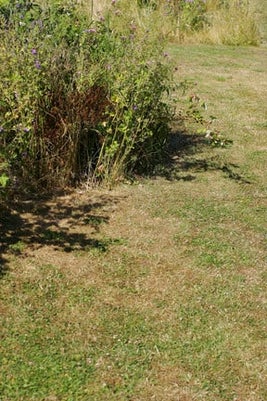
Quick facts
Common name - Dry patch
Scientific name - None
Plants affected - Turf
Main symptoms - Patches of dead grass with bone-dry soil below. The affected areas will not re-wet
Caused by - Water-repellent soil
Timing - Summer
What is dry patch?
Dry patch is just one of the many factors that can cause the appearance of dead patches in lawns. Other possibilities include feeding damage from invertebrates such as leatherjackets and wireworms, fungal diseases, spilt mower fuel, and dog or fox urine.
Dry soil due to prolonged hot, dry weather will also cause the grass to turn brown, but in this case there is usually good recovery once rain returns. However, with dry patch there is no recovery after rain as the water cannot penetrate the soil to reach the roots.
The causes of dry patch are complex and poorly understood, but a common cause is thought to be the coating of soil particles with water-repellent chemicals due to the growth of fungi.
Symptoms
You may see the following symptoms:
- Patches or irregular areas of the lawn turn first a darker green colour, and then brown
- The symptoms may develop during dry weather, but the problem does not improve with the return of rain or by watering the patches
- The soil underneath the affected patches will be found to be completely dry. Any water applied will simply run off or sit on the surface of the soil
- In extreme cases puddles may form on the surface following rainfall, as if the area is , but the soil will still be bone-dry beneath
- Occasionally (but by no means always) there may be an obvious white growth of fungal mycelium visible in, or a fungus-like smell to, the thatch layer or soil
Control
Non-chemical control
To help prevent dry patch:
- Scarify the lawn in autumn to remove accumulations of thatch
- Avoid soil compaction, and improve water and air penetration to the roots by (spiking) the lawn, e.g. with a fork or a hollow-tine cultivator
- Feed at the appropriate times to promote strong, healthy growth with a vigorous root system
If dry patch develops it can be very difficult to re-wet the soil, but the following may help:
- Spike the area densely, and attempt to apply some water each day for a few days (don’t overwater as it will just run off)
- Consider applying a wetting agent (see chemical control, below)
- Repeat the treatment once a month for 3-4 months
- In severe cases that do not respond to treatment, the affected turf plus 8-10 cm (3-4") of soil may need to be removed, and the soil replaced before re-seeding or re-laying with fresh turf
Chemical control
Products known as wetting agents are often used by sports turf professionals to treat dry patch. These are chemicals that aid the absorption of water by soil particles. Repeat treatment is likely to be necessary, in conjunction with the cultural methods outlined above.
Biology
Dry patch is still relatively poorly understood, and may have a number of different causes. One of the most common, however, is thought to be the deposition of water-repellent substances on soil particles by fungi growing through the thatch layer and amongst the roots. Even if the grass has an extensive root system the water cannot get to the roots and the plant effectively suffers from severe drought, even in wet weather.
These fungi are often not pathogenic species that directly attack the grass, and many may simply be helping to break down the dead roots, stems and leaves in the thatch layer. However, it is known that some of the fungi that cause fairy rings can also leave behind water repellent substances as they move through the soil.
Dry patch is also sometimes thought to occur as a result of chemical or physical changes within the soil itself, leading to reduced water penetration.
Factors that may make a lawn more prone to dry patch include compaction, light soil and a thick accumulation of thatch.









